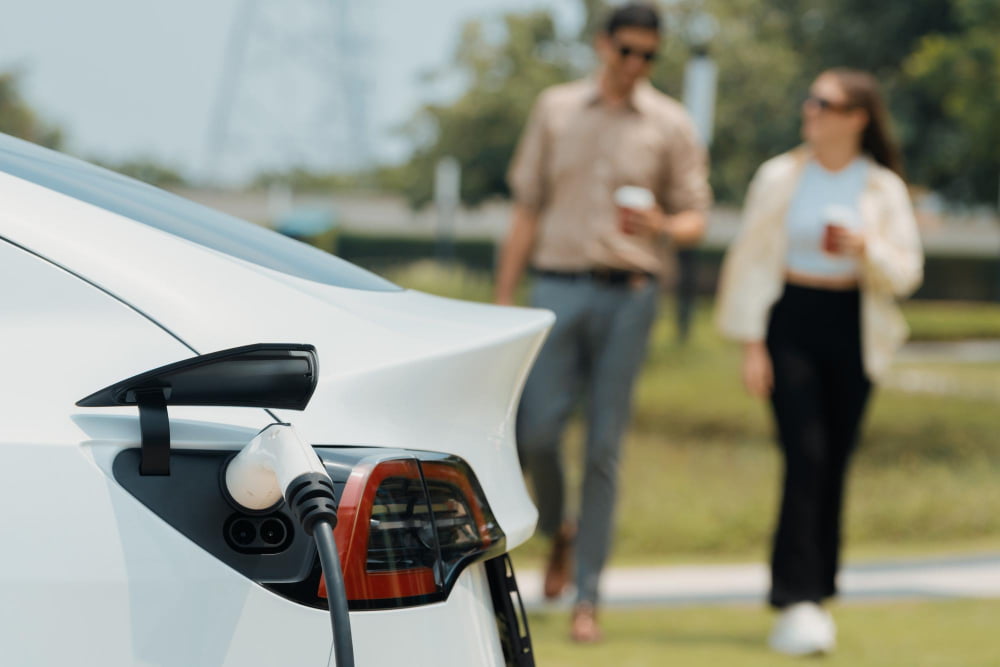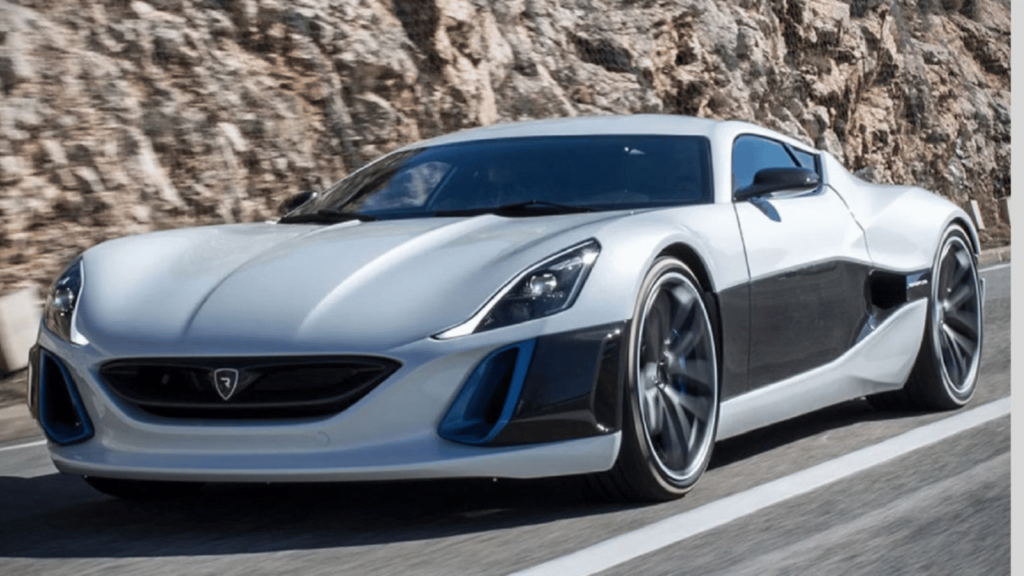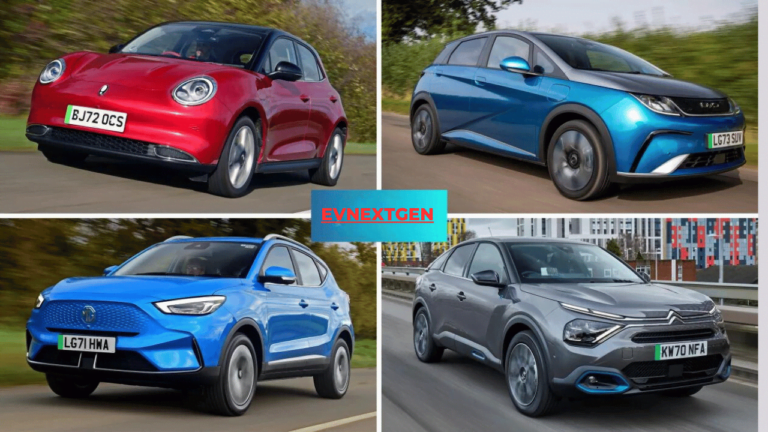The debate between electric vehicles (EVs) and gasoline cars is growing. More drivers are looking at sustainability and energy efficiency. It’s important to know the good and bad of each to make a smart choice EV vs Gas Car.
Electric vehicles are becoming popular because they cost less to run and are better for the planet. Studies show EV owners can save a lot over time, but the savings depend on where you live and how you drive. Gas cars are cheaper to buy but can cost more over time because of maintenance and changing fuel prices.
Most EVs can go over 200 miles on one charge, making “range anxiety” less of a worry. Gas cars have more places to fill up, but there are more charging stations for EVs now.
EVs have instant power and smooth acceleration, often beating gas cars in city driving. But gas cars are better for long trips and refueling fast. As technology gets better, both cars are getting more efficient and capable.
Key Takeaways
- EVs offer lower operational costs and reduced emissions compared to gas cars.
- Initial purchase prices for EVs are higher, but long-term savings can offset the difference.
- Electric cars require less maintenance than their gasoline counterparts.
- Gas vehicles still have advantages in refueling convenience and long-distance travel.
- Both types of cars are evolving, with improvements in efficiency and performance.
- The choice between EV and gas depends on individual driving needs and local infrastructure.
Introduction to Electric and Gas-Powered Vehicles
The world of cars is changing fast, with electric vehicles (EVs) becoming more popular than traditional gas cars. This change is a big deal in transportation history. Ev technology vs internal combustion engines is now a big topic for car lovers and those who care about the planet.
A Glimpse into the Past
EVs aren’t new. Back in the early 1900s, they made up a third of all cars in the U.S. But as gas cars got cheaper, EVs became less popular. The 1970s saw EVs make a comeback, but these early models were slow and didn’t go far.
The EV Renaissance
The 1990s brought new life to EVs. Cars like the GM EV1 could speed up fast and go 80 miles on a single charge. The Toyota Prius, which came out in 1997, made people really take notice of hybrid cars.
Current Market Trends
Now, the benefits of electric vehicles are clear. They’re quieter, need less upkeep, and don’t emit any pollutants. Even though gas cars are still more common because they’re cheaper upfront and go farther, EVs are gaining ground fast.
| Feature | Electric Vehicles | Gas-Powered Vehicles |
|---|---|---|
| Fuel Cost (per gallon equivalent) | $1.25 | $2.50 |
| Maintenance | Lower costs, fewer parts | Higher costs, more parts |
| Emissions | Zero tailpipe emissions | Contributes to air pollution |
As concerns about gasoline vehicle emissions grow, EVs are set to become even more popular. Experts predict EV sales could hit 7% of all new car sales by 2020. That means around 6.6 million EVs sold worldwide every year.
Initial Costs: Sticker Prices and Incentives
Electric vehicle costs might seem high at first. In early 2024, a new EV cost about $54,021, which is $13,000 more than a gas-powered car. This price difference comes from the advanced battery technology and special parts in EVs.
Government incentives help make EVs more affordable. The federal EV tax credit can give up to $7,500 for new EVs and $4,000 for used ones. Some states add more benefits. For example, in New Jersey, EV buyers can save around $10,000 over five years with incentives like sales tax exemptions.
The difference between ev tax credits and gas taxes changes by location. In New Jersey, EV owners save a lot, but in West Virginia, they might spend $1,800 more over five years than gas car owners. At least 32 states charge EVs an annual fee, ranging from $50 to $225.
| Cost Factor | Electric Vehicles | Gas Vehicles |
|---|---|---|
| Average New Vehicle Price (2024) | $54,021 | $41,021 (approx.) |
| Federal Tax Credit | Up to $7,500 | N/A |
| Home Charging Installation | ~$1,300 | N/A |
| 5-Year Ownership Savings | $3,000 (average) | Baseline |
Even with higher prices, EVs are often cheaper over time. They usually cost about $3,000 less over five years than gas cars, due to lower fuel and maintenance costs. As battery technology gets better, the price difference between EVs and gas cars will keep getting smaller. This makes EVs a more appealing choice for buyers.
Fuel Efficiency and Energy Costs
When we look at electric vehicles (EVs) versus gas cars, fuel efficiency is a big deal. EVs are great at turning energy into power, with over 90% efficiency. Gas cars, on the other hand, only get about 40% efficient.
Electricity vs. Gasoline Prices
The U.S. Environmental Protection Agency created Miles Per Gallon Equivalent (MPGe) to help us compare EVs with traditional cars. For example, the 2021 Chevrolet Bolt EV has amazing MPGe ratings of 127 City, 108 Highway, and 118 Combined. This shows how much you could save on fuel.
Regional Cost Variations
EV energy costs change depending on where you live because of different electricity prices. Some places offer big savings, while others might cost more. For instance, EV owners in areas with low electricity rates could save thousands over the life of their car.
Long-term Savings Potential
Even though EVs might cost more at first, they’re often cheaper in the long run. When you look at energy efficiency, electricity prices, and less maintenance, you can see big savings. EVs have lower average annual fuel costs than gas cars, which helps save money over time.
| Vehicle Type | Energy Efficiency | Annual Fuel Cost | Range (miles) |
|---|---|---|---|
| 2022 Tesla Model S | 120 MPGe | $550 | 405 |
| 2022 Chevrolet Bolt EV | 120 MPGe | $550 | 259 |
| 2022 Rivian R1S | 60 MPGe | $950 | 316 |
Environmental Impact and Sustainability
Looking at electric vehicles (EVs) and gas cars, we see big differences in their carbon footprints. EVs don’t emit tailpipe pollution. But, their environmental impact depends on how they’re made and charged.
Gas cars pollute the air and contribute to climate change. They release about 350 grams of CO2 per mile. Each gallon of gasoline burned adds around 8,887 grams of CO2. EVs, on the other hand, have much lower emissions, especially when charged with renewable energy.
Research shows EVs are better for the environment than gas cars 95% of the time. Over their life, EVs emit about half the greenhouse gases of similar gas or diesel cars. This is because electric motors are more efficient, turning up to 85% of energy into motion. Gas engines only convert less than 40%.
| Vehicle Type | Energy Efficiency | Lifetime Emissions |
|---|---|---|
| Electric Vehicles | 85% energy conversion | 50% of gas vehicle emissions |
| Gas-Powered Vehicles | Less than 40% energy conversion | 100% baseline emissions |
EVs are more sustainable than just driving. They use 58% less energy than gas cars. Making EV batteries does have environmental costs, but new tech and better practices are cutting down on this. Future battery recycling could also reduce mining needs, making EVs even more sustainable.
Performance and Driving Experience
Driving an electric vehicle (EV) is quite different from driving a car with a gas engine. EVs have special performance traits that make them stand out.
Acceleration and Power Delivery
EVs are great at accelerating, often beating gas cars in speed. They go from 0 to 60 mph quicker because of instant torque. This means they have smooth power at any speed, making the driving experience better.
Handling and Ride Comfort
EVs have a lower center of gravity, which makes them more stable and easier to handle. The placement of battery packs helps with balance, making driving smoother. EVs also have a smoother ride with less shaking than gas cars.
Noise Levels and Vibration
EVs are much quieter than gas cars. They create a peaceful driving space for everyone inside. Without a combustion engine, there’s less noise and shaking, making for a quieter, more comfortable ride.
| Aspect | Electric Vehicles | Gas Vehicles |
|---|---|---|
| Acceleration | Faster 0-60 mph | Generally slower |
| Power Delivery | Instant torque | Gradual power build-up |
| Noise Level | Very quiet | Engine noise present |
| Vibration | Minimal | Noticeable engine vibration |
EVs offer a unique driving experience that many find exciting and new. This is different from the usual feel of driving a gas-powered car.
Maintenance and Repair Considerations
When looking at ev maintenance vs gas maintenance, electric vehicles (EVs) are often the better choice. EVs have fewer parts, which means they cost less to maintain over time. They don’t need oil changes and brakes wear down less because of regenerative braking.
Studies show EVs are cheaper to maintain than cars with traditional engines. EV repairs are about $1,000 more on average. But, this difference is much smaller when you leave out Tesla repairs, at just $269.
Even with lower daily maintenance costs, EVs can face big expenses for battery replacements. It’s key to think about these costs when comparing ev maintenance costs vs gas costs.
| Aspect | Electric Vehicles | Gas-Powered Vehicles |
|---|---|---|
| Oil Changes | Not required | Regular maintenance |
| Brake Wear | Reduced due to regenerative braking | Normal wear and tear |
| Average Repair Costs | $1,000 higher than ICE vehicles | Lower than EVs |
| Long-Term Expense | Potential battery replacement | Ongoing engine maintenance |
EVs might cost more at first, but they save money over time because they need less maintenance. As technology gets better and more people choose EVs, maintenance costs will likely go down. This makes electric vehicles a smart choice for drivers watching their budgets.
Range and Refueling/Charging Infrastructure
When looking at electric vehicles (EVs) versus gas cars, the range and how to refuel are key points. We’ll dive into the differences between ev range and gas mileage. We’ll also look at ev charging versus gas refueling.
Typical Driving Ranges
Gas cars usually go 400-800 miles on a tank. EVs, however, have a shorter range, but newer models can go 200-300 miles per charge. This difference affects how drivers plan their trips.
Charging Infrastructure Availability
Gas stations are easy to find, but charging spots for EVs are getting more common. EV owners can charge at home every day, making public charging less needed. But, planning charging stops is key for long trips.
Refueling Times and Costs
Refueling a gas car is quick, but charging an EV can take 30 minutes to several hours. Despite this, EVs are cheaper to run. Let’s see how much you could save each month:
| Vehicle Type | Monthly Cost | Annual Cost |
|---|---|---|
| Electric Vehicle | $66.66 | $799.92 |
| Gas-powered Car | $182.50 | $2,190.00 |
EV owners could save $1,390.08 a year. With more charging spots and better batteries, EVs are becoming a smarter choice for many drivers.
EV vs Gas Car: A Direct Comparison
When looking at electric vehicles (EVs) and gas cars, the cost over time is key. A 2024 study found EVs are cheaper to own for seven years, saving between $7,000 and $11,000. This shows EVs are a smart choice even with their higher initial cost.
EVs and gas cars have big differences in emissions. EVs don’t emit pollutants directly, unlike gas cars. In places with clean energy, EVs are better for the environment over their life.
Electric vehicles are more energy-efficient. The EPA uses miles per gallon equivalent (MPGe) to measure this. Many EVs have MPGe ratings over 100, showing they use energy better than gas cars.
| Feature | Electric Vehicle | Gas Car |
|---|---|---|
| Direct Emissions | Zero | Produces through tailpipe |
| Fuel Efficiency | 100+ MPGe | Varies, typically lower |
| Range | 200-300+ miles | 300-400+ miles |
| Incentives | Up to $7,500 federal tax credit | None |
Choosing between an EV and a gas car depends on your needs and where you live. With more people buying EVs and more charging spots, they’re becoming a great choice for many.
Future Outlook: Technological Advancements and Market Trends
The future of electric vehicles (EVs) is looking bright. We’re seeing fast progress in battery technology and changes in the market. The car industry is changing quickly.
Emerging Battery Technologies
Battery technology is leading the way in EV innovation. Prices have dropped a lot, with a big 87% decrease since 2008, says the U.S. Department of Energy. This makes EVs cheaper and more people can buy them.
Government Incentives and Industry Shifts
Government incentives are helping make EVs more popular. In the U.S., the Tesla Model Y saw a 50% sales boost after getting tax credits. With support from governments and companies, the market is changing. Six big car makers have promised to stop selling gas cars by 2040, showing a big move to electric.
Global Market Trends
The global EV market is growing fast. China is leading with almost 60% of new electric car sales in 2023. The U.S. and Europe saw big increases too. Countries like India, Thailand, and Brazil are also seeing more people choosing EVs.
With better batteries and government support, EVs have a bright future. Over 100 new EV models are coming soon, giving buyers more choices. This could make EVs 40-60% of new car sales by 2030.
Conclusion
The debate between electric vehicles and gasoline cars is getting more intense as the auto industry changes. EVs have grown a lot, with their global market share jumping to 8.5% in 2021. This shows a move towards using less energy and being more eco-friendly in how we travel.
When we look at electric vs gas cars, there are many things to consider. EVs are better for the environment, creating half the CO₂ of traditional cars over their life. They also cost less to maintain, at $0.90 per mile compared to $0.10 for gas cars. But, gas cars are still cheaper to start with and go farther on a full tank.
The difference between EVs and gas cars is likely to get bigger. As electricity gets cleaner and batteries get better, EVs will be even more eco-friendly. With the U.S. investing $312 billion in EV production, electric cars look set for a bright future. In the end, choosing between an EV and a gas car depends on what you need, how you drive, and what’s available in your area.












